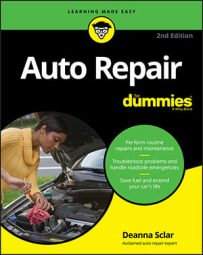Faulty or old weather stripping should be replaced to prevent whistles and leaks inside your vehicle. If your car's interior or trunk gets wet when you wash the car or when it rains, use a garden hose to locate the areas on the weather stripping that let the water in. If the windows whistle when you drive with them closed, check the weather stripping for the cause of the sound effects.
If your old weather stripping is in pretty good shape but is letting in air or water in one or two small areas, try applying weather stripping adhesive under the loose portions, or use a clear silicone sealer (which comes in a tube) to seal around the areas that leak.
If the weather stripping is old, dried, cracked, or worn, you can probably buy a whole new piece designed for your vehicle’s make, model, and year at your dealer’s service department.To install new weather stripping, follow these steps:
-
Check to see whether the new weather stripping is the same as the old piece you’re replacing.
The piece should be the same shape and thickness and should have holes, channels, and rubber studs on the inner side that match the ones on the original.
-
Remove any screws and gently peel off the old weather stripping, prying any rubber studs out of the holes they’re inserted into without damaging the paint or scratching the surrounding trim.
If the weather stripping is hard to remove, spray weather stripping remover around the area and wait until the adhesive softens before continuing.
-
Remove any old adhesive that remains on the frame after the seal is gone.
Use weather stripping remover.
-
Insert the new weather stripping into the frame.
Make sure that it fits the holes and contours of the frame. Then gently remove it.
-
Make sure that the new weather stripping is clean.
Either rinse it off and dry it thoroughly or use fine-grain sandpaper to remove any unwanted bumps and rough spots.
-
Apply weather stripping adhesive sparingly to the strip and to the surface of the frame.
-
Before the adhesive dries, replace the new weather stripping.
Make sure that every rubber stud or other fastening device is in its hole securely.
-
Replace any screws that you removed, and make sure that the ends of the weather stripping meet and are glued down securely.
A quick and easy way to patch things up if you don’t care how they look is to get a roll of black household weather stripping about a half-inch wide with an adhesive back and simply stick small pieces of it onto or under the weather stripping in the trouble areas. This stuff is also useful for keeping camper hatches and sunroofs from leaking or banging if they don’t fit quite perfectly and for keeping rain from coming past the rubber sleeve where the camper shell meets the cab of a truck. You can always use it around the house, too!

